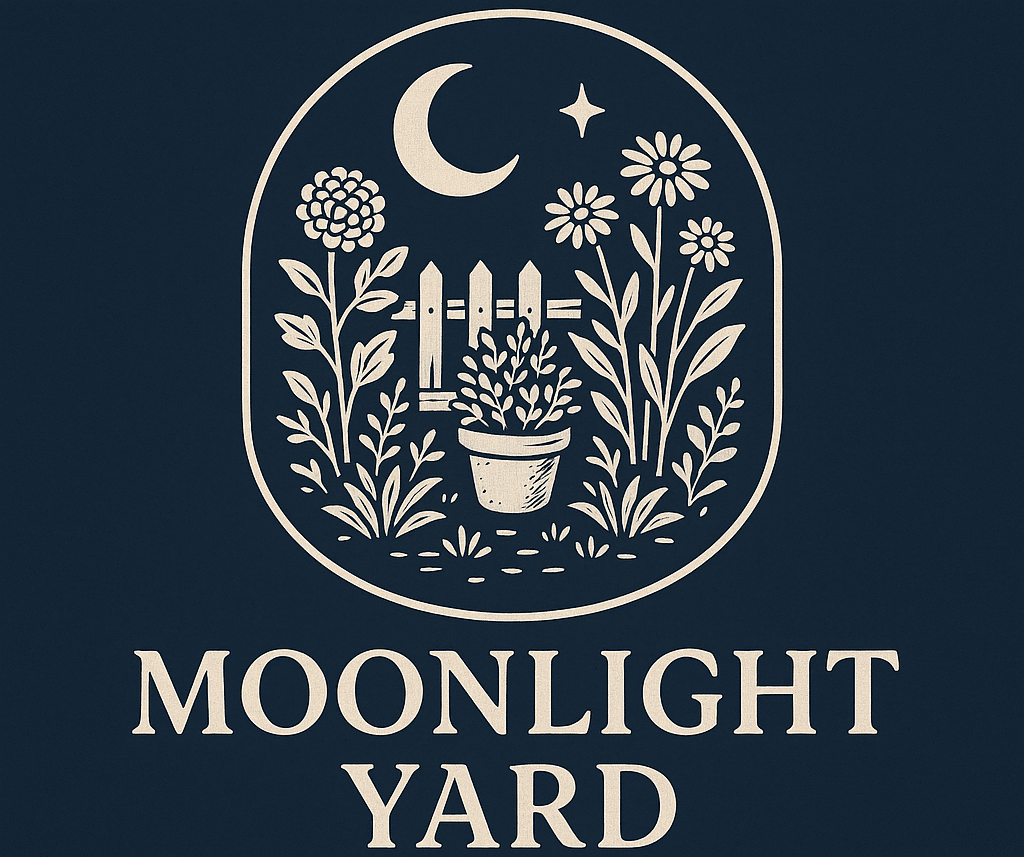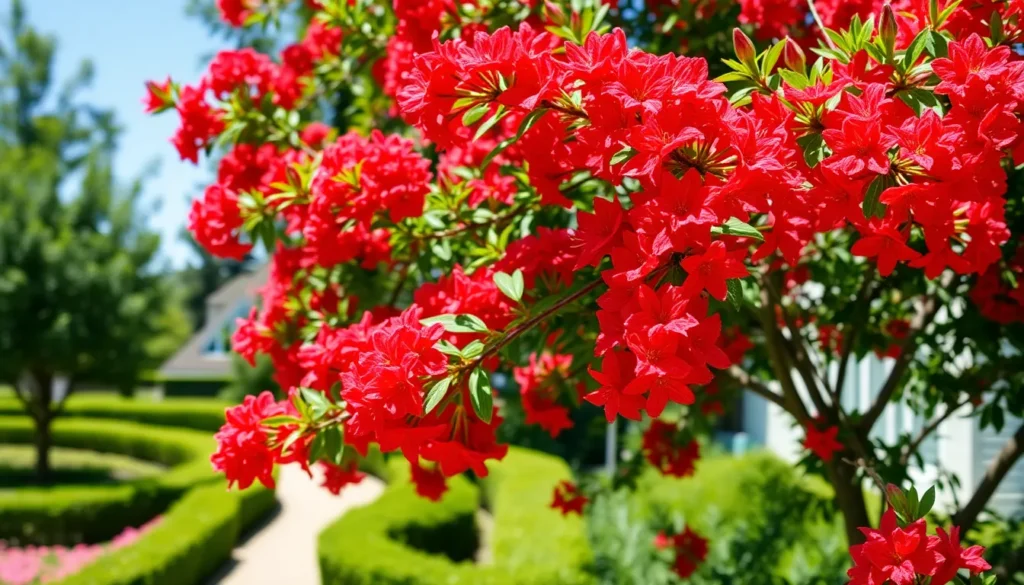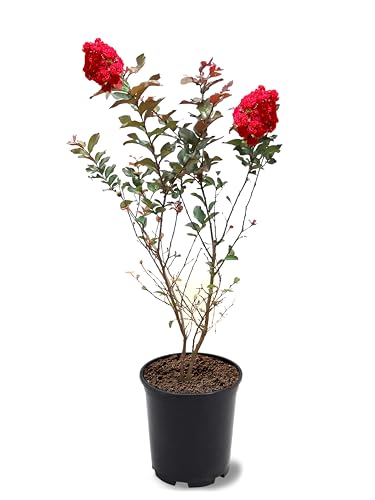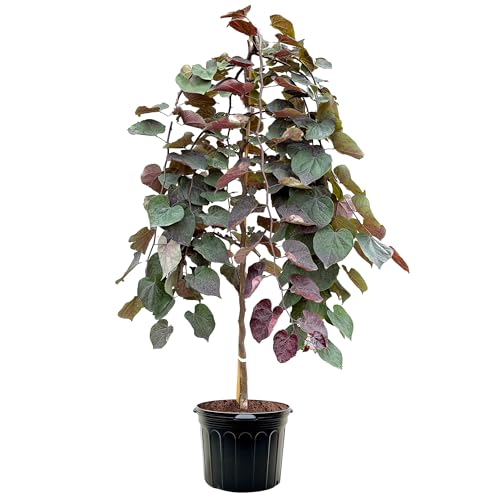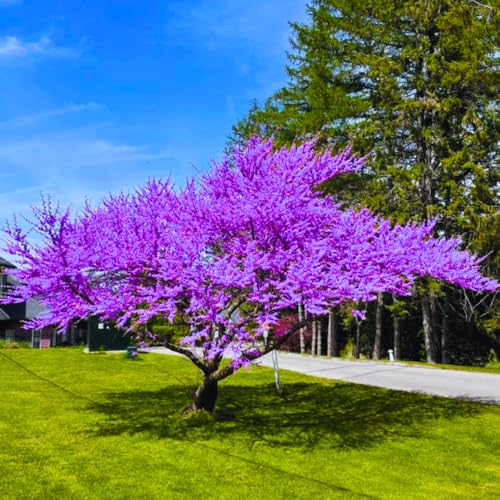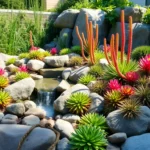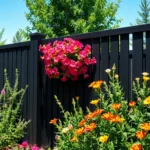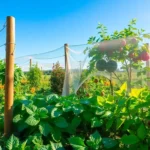When we think about transforming our landscapes into breathtaking displays of natural beauty, red flowering trees stand out as nature’s most dramatic performers. These stunning specimens create bold focal points that command attention and turn ordinary yards into extraordinary outdoor sanctuaries.
We’ve discovered that red-bloomed trees offer something truly special – they’re not just plants, they’re living art pieces that paint our surroundings with vibrant crimson hues. From the early spring explosions of cherry blossoms to the late summer drama of crepe myrtles, these trees deliver year-round visual impact that neighbors can’t help but admire.
Whether you’re planning a complete industry overhaul or simply want to add that perfect pop of color, red flowering trees provide unmatched versatility and stunning results. They’re easier to grow than you might think, and we’re here to show you exactly how to choose, plant, and care for these magnificent additions to your outdoor space.
Maple Trees: Nature’s Crimson Crown Jewels
Maple trees deliver some of the most spectacular red displays in the tree kingdom. These magnificent specimens transform our landscapes with their brilliant crimson foliage and elegant branching patterns.
Japanese Red Maple (Acer palmatum)
Japanese Red Maples create stunning focal points with their delicate, hand-shaped leaves that emerge bright red in spring. We’ve found these ornamental treasures thrive in partial shade, making them perfect for understory plantings beneath larger trees. Their compact size typically reaches 15-25 feet at maturity, fitting beautifully into smaller garden spaces.
Cultivating these crimson beauties requires well-draining soil with consistent moisture throughout the growing season. Popular varieties like ‘Bloodgood’ and ‘Emperor I’ maintain their deep red coloration from spring through fall. These maples prefer protection from harsh afternoon sun, which can scorch their tender leaves and fade their vibrant hues.
Red Sunset Maple (Acer rubrum)
Red Sunset Maples earn their reputation as America’s most beloved native maple through their exceptional fall color display. We recommend these fast-growing giants for homeowners seeking dramatic seasonal transformation, as they reach 40-50 feet with a rounded crown. Their spring flowers appear as tiny red clusters before the leaves emerge, adding early season interest to the industry.
Adaptability makes Red Sunset Maples excellent choices for various soil conditions, from wet bottomlands to drier upland sites. These hardy trees tolerate urban pollution and salt spray better than most maple species. Their brilliant orange-red fall foliage lasts longer than other maples, extending the autumn color show by several weeks.
Crimson King Norway Maple (Acer platanoides)
Crimson King Norway Maples provide year-round red foliage that sets them apart from other maple species. We appreciate their consistent deep purple-red leaves that maintain their color intensity throughout the growing season. These robust trees grow 35-45 feet tall with a dense, oval crown that creates excellent shade coverage.
Durability defines the Crimson King’s appeal, as these maples withstand drought, pollution, and compacted soils better than most ornamental trees. Their shallow root system requires careful consideration near sidewalks and foundations. Yellow flowers contrast beautifully against the dark red foliage in early spring, followed by winged seeds that add textural interest.
Flowering Fruit Trees That Paint the Landscape Red
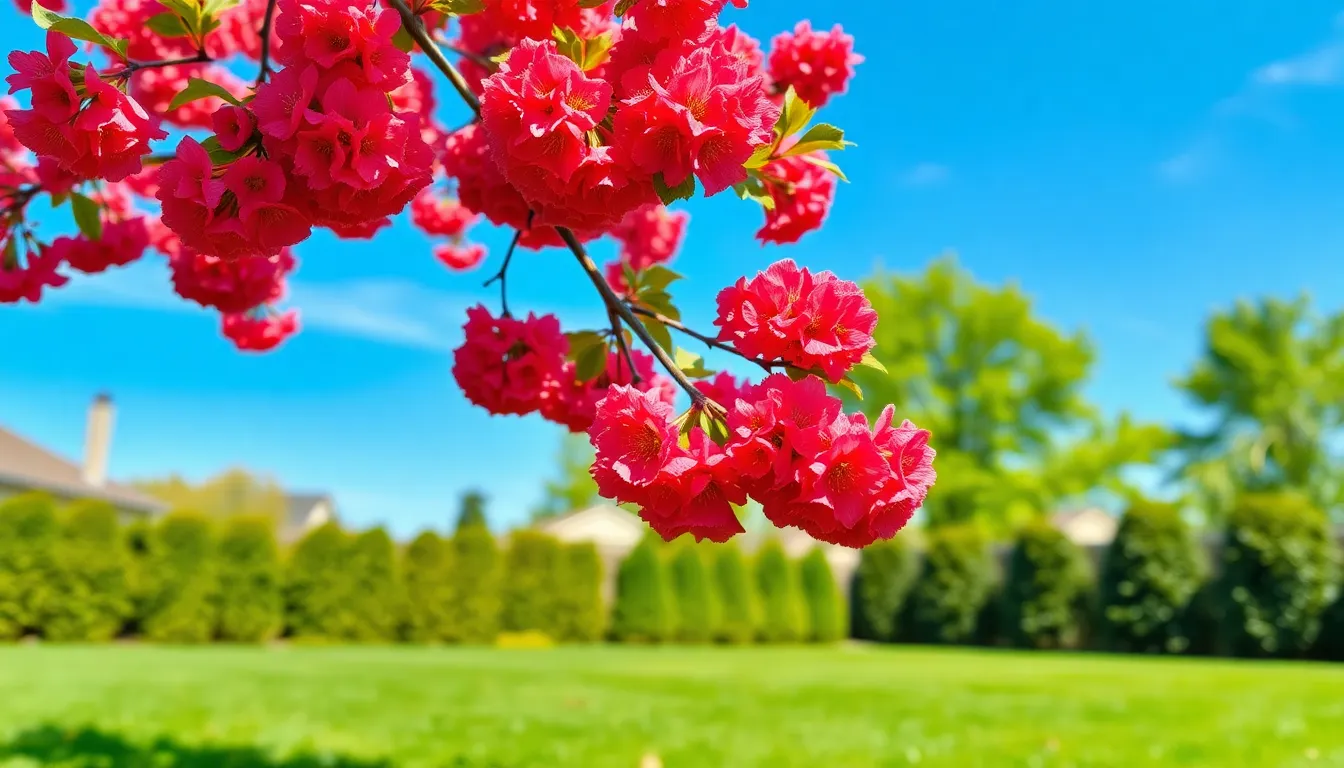
Fruit trees offer more than just delicious harvests – many varieties produce stunning red blooms that transform ordinary yards into breathtaking displays. We’ve carefully selected three exceptional flowering fruit trees that deliver spectacular crimson flowers while providing functional beauty to your industry.
Red Flowering Crabapple (Malus)
Red Flowering Crabapples stand out as one of the most popular ornamental trees for their stunning red blossoms and exceptional durability. These hardy trees produce masses of vibrant crimson flowers in early spring, creating a dramatic focal point that signals the arrival of warmer weather. We recommend crabapples for their low maintenance requirements and ability to thrive in various soil conditions.
Landscapers consistently choose Red Flowering Crabapples because they offer both beauty and resilience in challenging environments. The trees typically reach 15-25 feet in height and spread, making them perfect for medium-sized yards where you want maximum impact without overwhelming the space. Their red blooms attract pollinators like bees and butterflies, supporting local ecosystems while providing visual appeal.
Cherry Blossom Trees (Prunus serrulata)
Cherry Blossom Trees captivate homeowners with their delicate red flower varieties, though most people associate them with pink and white blooms. Red flowering cherry cultivars create spectacular spring displays that rival their more common pink counterparts. We find these trees particularly striking when planted in groups or along walkways where their graceful branching pattern can be fully appreciated.
These ornamental cherries bloom for approximately two weeks in early to mid-spring, depending on your climate zone. The flowers appear before the leaves emerge, creating a stunning silhouette of pure color against bare branches. Red flowering cherries prefer well-drained soil and full sun exposure to produce their most vibrant blooms.
Red Flowering Peach (Prunus persica)
Red Flowering Peaches earn recognition for their early, vivid red flowers that brighten landscapes when most other trees remain dormant. Southern California gardeners particularly value these trees for their decorative appeal during Chinese New Year celebrations and other spring festivities. We appreciate how these trees provide both ornamental beauty and potential fruit production in a single planting.
The blooms emerge in late winter to early spring, often appearing before the last frost danger passes. This early flowering habit makes Red Flowering Peaches valuable for extending your garden’s color season. These trees adapt well to Mediterranean climates and require minimal water once established, making them excellent choices for drought-conscious landscaping.
Tropical Red Flowering Trees for Warm Climates
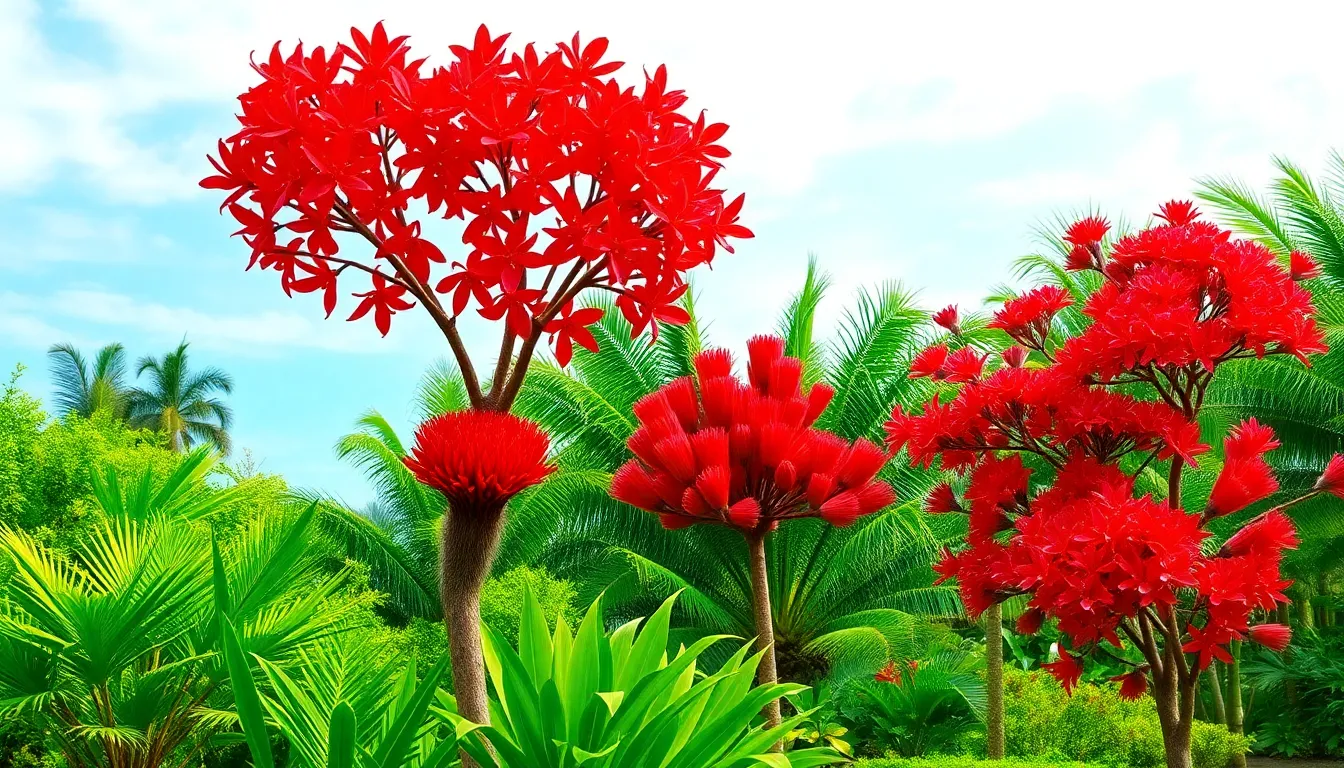
We discover some of the most spectacular red flowering displays when exploring tropical trees designed for consistently warm regions. These magnificent specimens thrive in areas where winter temperatures rarely dip below freezing.
Royal Poinciana (Delonix regia)
Royal Poncianas create one of nature’s most dramatic displays with their fiery red blooms during late spring to early summer. Growing 30 to 40 feet tall, these majestic trees transform landscapes in USDA zones 9-12 with their flame-colored flowers that seem to dance against emerald green foliage.
Optimal Growing Conditions:
| Requirement | Specification |
|---|---|
| Sun Exposure | Full sun |
| Soil Type | Well-drained |
| USDA Zones | 9-12 |
| Mature Height | 30-40 feet |
| Drought Tolerance | High once established |
| Salt Tolerance | Yes |
Established Royal Poncianas demonstrate remarkable resilience against drought conditions and salt exposure, making them perfect for coastal tropical gardens. We appreciate how these trees provide dappled shade beneath their wide-spreading canopy while maintaining their stunning visual impact throughout the blooming season.
Bottlebrush Tree (Callistemon)
Bottlebrush trees produce distinctive bright red flowers that perfectly resemble their namesake cleaning tool. Blooming from spring to early summer, these hardy specimens adapt well to USDA zones 8-11 and prefer full sun exposure for optimal flower production.
Key Growing Requirements:
| Factor | Preference |
|---|---|
| Light | Full sun |
| Soil | Well-drained |
| USDA Zones | 8-11 |
| Bloom Period | Spring to early summer |
We find these trees particularly valuable for their unique flower structure and reliable blooming habits. Full sun locations encourage the most vibrant red coloration in their cylindrical flower clusters, while well-drained soil prevents root problems that can affect overall tree health.
Red Silk Cotton Tree (Bombax ceiba)
Red Silk Cotton trees showcase large, striking red flowers that create breathtaking displays during late winter to early spring. Thriving in warm tropical climates, these impressive specimens prefer well-drained soil conditions and adequate spacing to accommodate their substantial mature size.
Growing Specifications:
| Aspect | Requirement |
|---|---|
| Climate | Warm tropical zones |
| Soil | Well-drained |
| Bloom Time | Late winter to early spring |
| Flower Size | Large |
We observe that these trees offer unique timing advantages by blooming before many other tropical species begin their growing season. Well-drained soil becomes essential for preventing waterlogged conditions that can damage the extensive root systems these magnificent trees develop over time.
Ornamental Red Flowering Trees for Garden Design
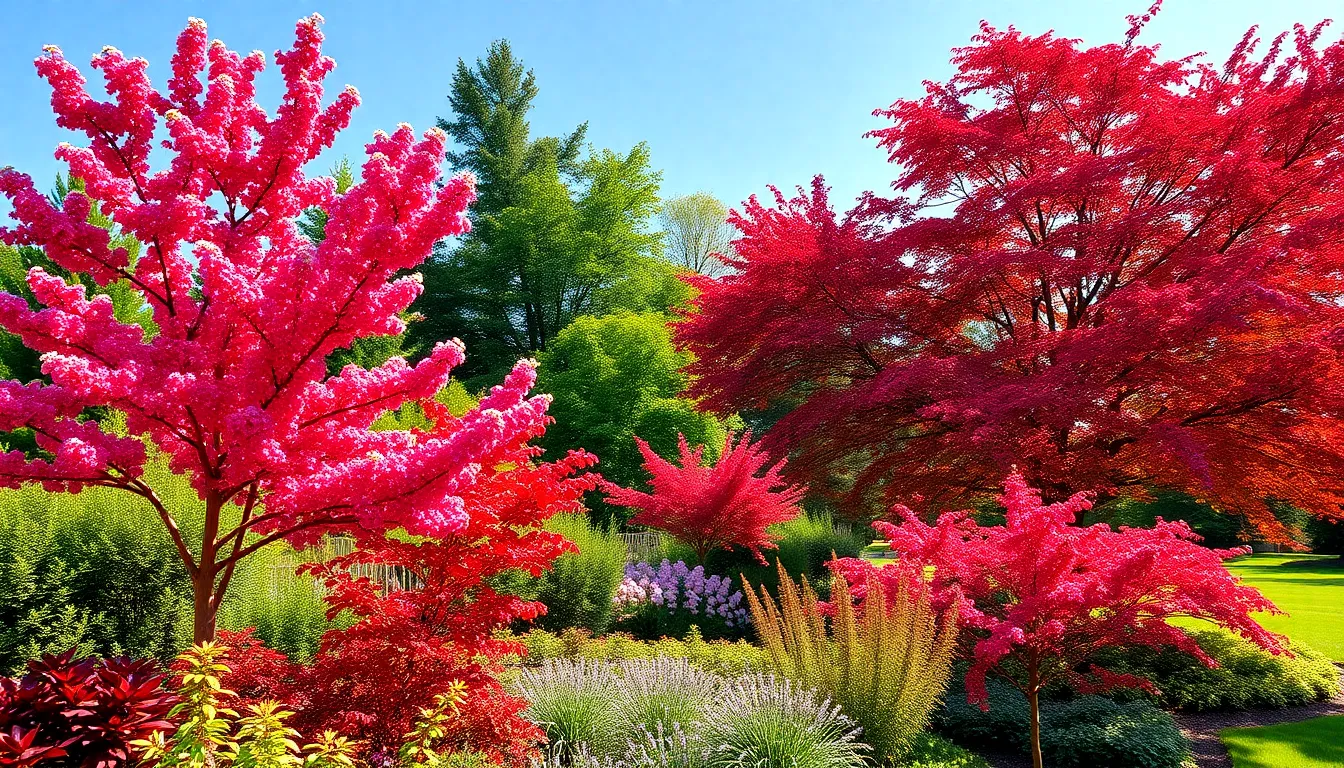
We’ve carefully selected these ornamental red flowering trees that offer distinctive characteristics for creating stunning garden focal points. Each variety brings unique blooming patterns and aesthetic qualities that complement various industry designs.
Eastern Redbud (Cercis canadensis)
Eastern Redbud delivers spectacular early spring color with its showy pink to red flowers that bloom directly along the branches before leaves emerge. This native North American tree creates a breathtaking display when planted as a specimen tree or grouped for maximum visual impact. We recommend planting Eastern Redbud in well-drained soils with full sun exposure to ensure optimal flowering performance.
Ruby Falls Redbud offers a compact alternative for smaller gardens while maintaining the same stunning bloom characteristics. Gardeners appreciate this tree’s heart-shaped leaves that provide beautiful green foliage throughout summer. The tree typically reaches heights of 20 to 30 feet, making it perfect for residential landscapes where space considerations matter.
Red Flowering Dogwood (Cornus florida)
Red Flowering Dogwood produces vibrant red bracts that create the appearance of large, showy flowers during spring blooming season. These distinctive bracts surround small white or pink actual flowers, creating a multi-layered color display that enhances any garden design. We’ve found this tree thrives in acidic to neutral soils with consistent moisture levels, making it ideal for shaded garden areas.
The tree’s green leaves provide excellent foliage contrast during summer months before transitioning to attractive fall colors. Mature Red Flowering Dogwoods typically reach 15 to 30 feet in height with equal spread. Garden designers often use this tree as an understory planting beneath larger shade trees where it receives filtered sunlight.
Scarlet Oak (Quercus coccinea)
Scarlet Oak stands out among red flowering trees for its exceptional autumn foliage display rather than traditional flower production. This native eastern North American tree develops deep red leaves during fall season, creating dramatic industry color when most other trees are dormant. We recommend Scarlet Oak for gardeners seeking long-term investment trees that provide decades of reliable autumn beauty.
The tree thrives in well-drained soils with full sun exposure, adapting well to various soil types including sandy and clay conditions. Mature specimens can reach impressive heights of 70 to 80 feet with broad, spreading canopies. Property owners value Scarlet Oak for its durability and low maintenance requirements once established in appropriate growing conditions.
Evergreen Red Flowering Trees for Year-Round Color
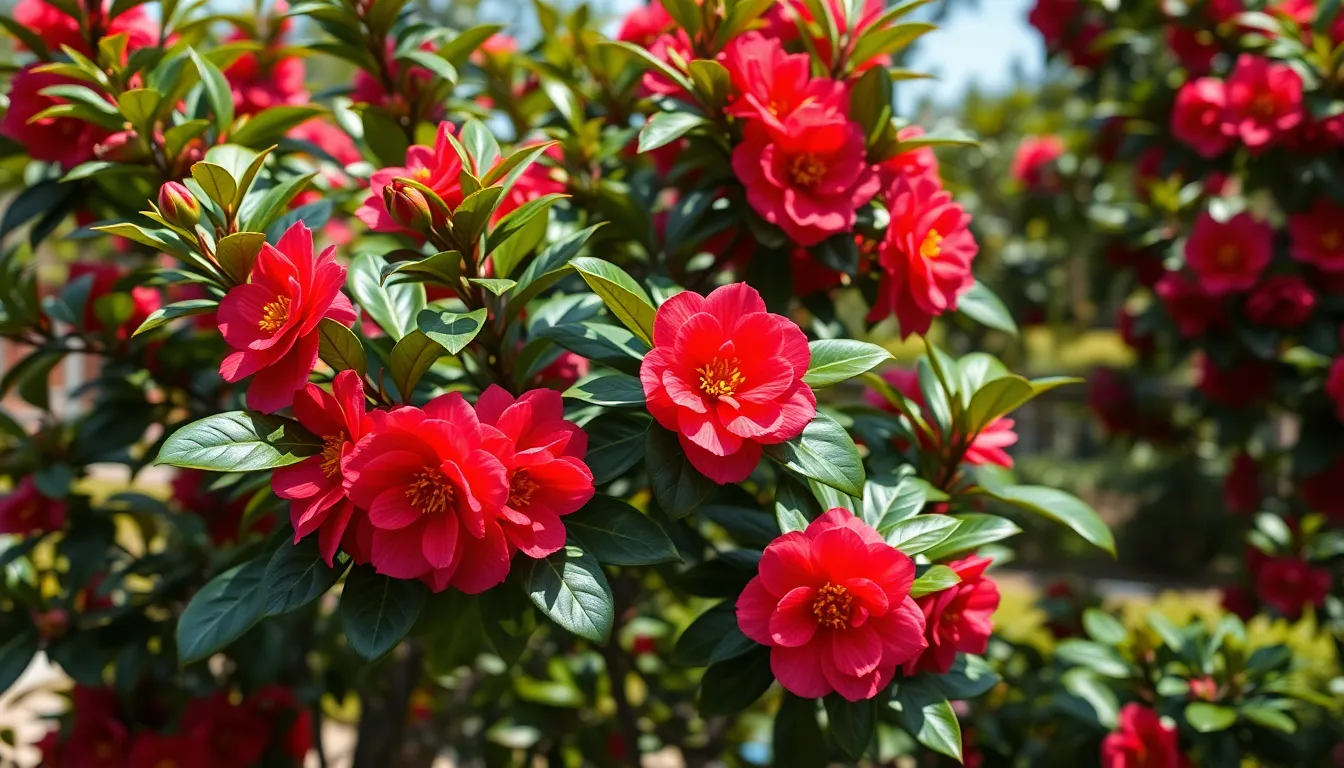
We’ve explored deciduous options that dazzle seasonally, but evergreen red flowering trees offer continuous beauty throughout the year. These remarkable specimens maintain their foliage while producing stunning crimson blooms, creating lasting focal points in any industry.
Red Camellia (Camellia japonica)
Red Camellia stands as one of our most prized evergreen flowering trees, producing large, showy red flowers that create dramatic visual impact. This elegant tree thrives in USDA zones 6 to 9, making it accessible to gardeners across diverse climates. Partial shade becomes essential for optimal growth, as these trees prefer protection from harsh afternoon sun.
Well-draining soil provides the foundation for healthy Red Camellia development, preventing root rot and ensuring vigorous blooming. Blooming typically occurs from late winter through early spring, offering vibrant color when most other trees remain dormant. Garden enthusiasts appreciate this tree’s glossy, dark green foliage that provides year-round structure and beauty.
Red Rhododendron Tree Forms
Red Rhododendron tree forms transform traditional shrubs into stunning specimen trees through careful training and pruning techniques. These evergreen beauties produce vibrant red flowers that cluster magnificently across their canopy. USDA zones 5 to 8 provide ideal growing conditions for these remarkable trees.
Acidic soils become crucial for Red Rhododendron success, as alkaline conditions can lead to yellowing leaves and poor flowering. Training involves selecting the strongest central leader and gradually removing lower branches to create a tree-like structure. Mature specimens can reach impressive heights while maintaining their characteristic dense, evergreen foliage.
Australian Flame Tree (Brachychiton acerifolius)
Australian Flame Tree creates one of nature’s most spectacular flowering displays with its brilliant clusters of bright red flowers. Native to Australia, this deciduous tree brings exotic beauty to warmer climates in USDA zones 9 to 11. Full sun exposure maximizes flowering potential and ensures the most vibrant red blooms.
Well-draining soil prevents root issues that can plague this tree in waterlogged conditions. Flowering typically occurs before leaf emergence, creating an even more dramatic effect as the entire canopy appears ablaze with red. Drought tolerance makes this tree particularly valuable in Mediterranean and subtropical climates where water conservation matters.
Native Red Flowering Trees by Geographic Region
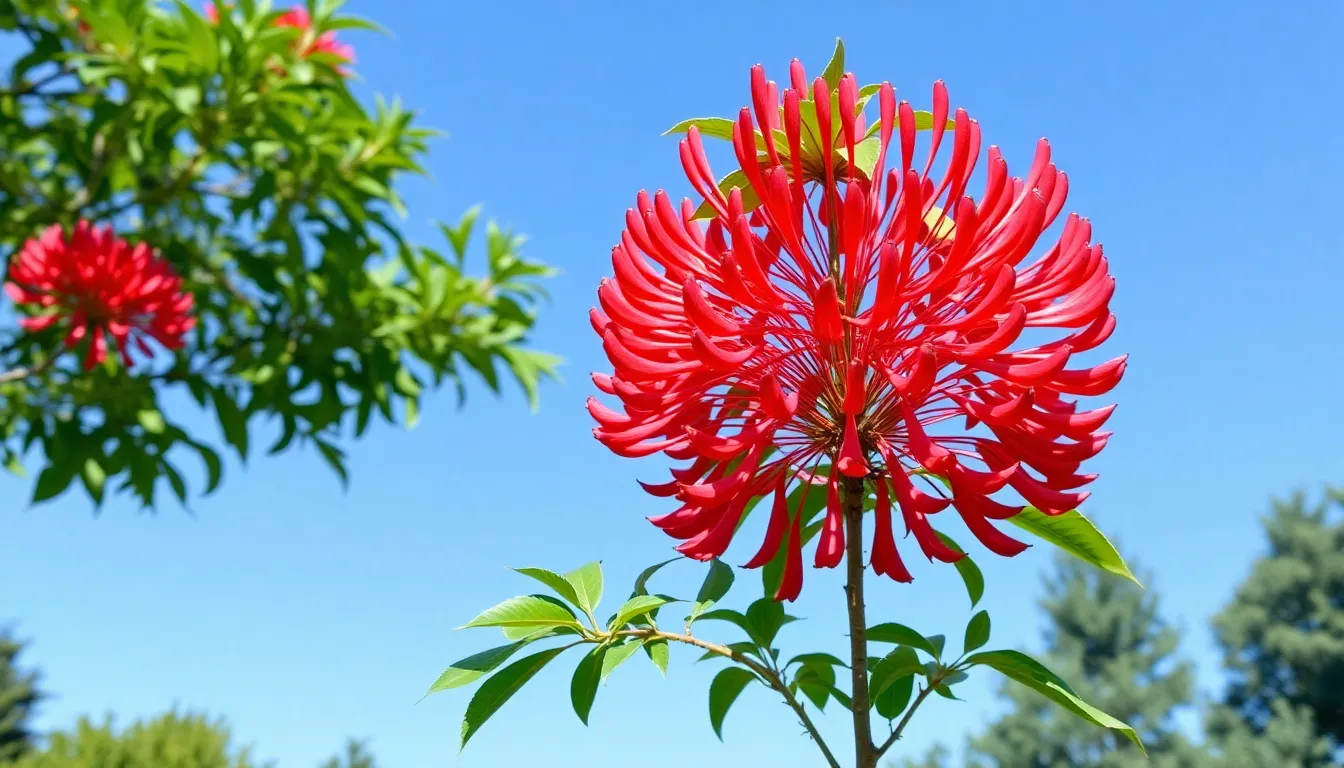
We’ve explored various red flowering trees from around the industry, but understanding native species offers unique advantages for sustainable landscaping. Native trees naturally thrive in their regional climates and support local ecosystems more effectively.
North American Native Species
Red Buckeye (Aesculus pavia) stands out as one of our most vibrant native options, producing spectacular red flowers in early spring throughout the eastern United States. This compact tree typically reaches 15-20 feet and attracts hummingbirds with its tubular crimson blooms. We recommend planting Red Buckeye in partial shade with well-draining soil for optimal performance.
Red Maple (Acer rubrum) provides early nectar sources for pollinators through its small red flowers that appear before the leaves emerge. Though these blooms aren’t as showy as ornamental varieties, they play a crucial role in supporting native wildlife. The tree’s fall foliage creates stunning red displays that complement its spring flowering period.
Mediterranean Climate Varieties
Red Flowering Oleander Tree thrives in warm Mediterranean climates even though not being native to these regions. These resilient trees produce clusters of vibrant red flowers throughout the growing season and tolerate drought conditions exceptionally well. We suggest using them as privacy screens or accent trees in USDA zones 8-11.
Crape Myrtle (Lagerstroemia) offers spectacular red flowering varieties that flourish in Mediterranean style climates. Popular cultivars like ‘Dynamite’ and ‘Red Rocket’ produce dense clusters of crinkled red blooms from summer into fall. These trees adapt well to hot, dry conditions and provide attractive exfoliating bark for winter interest.
Temperate Zone Options
Red Horse Chestnut (Aesculus × carnea) creates impressive spring displays with its upright clusters of red flowers in temperate climates. This hybrid tree combines the best traits of its parent species and typically grows 30-40 feet tall. We find it performs best in USDA zones 4-7 with consistent moisture and partial shade.
Scarlet Rose Mallow Hibiscus (Hibiscus coccineus) produces enormous red flowers up to 8 inches across on tall stems that can reach 8-10 feet. Though technically a herbaceous perennial, its impressive height and dramatic blooms create tree-like presence in temperate gardens. This native wetland plant thrives in consistently moist soils and full sun exposure.
Seasonal Care Tips for Red Flowering Trees
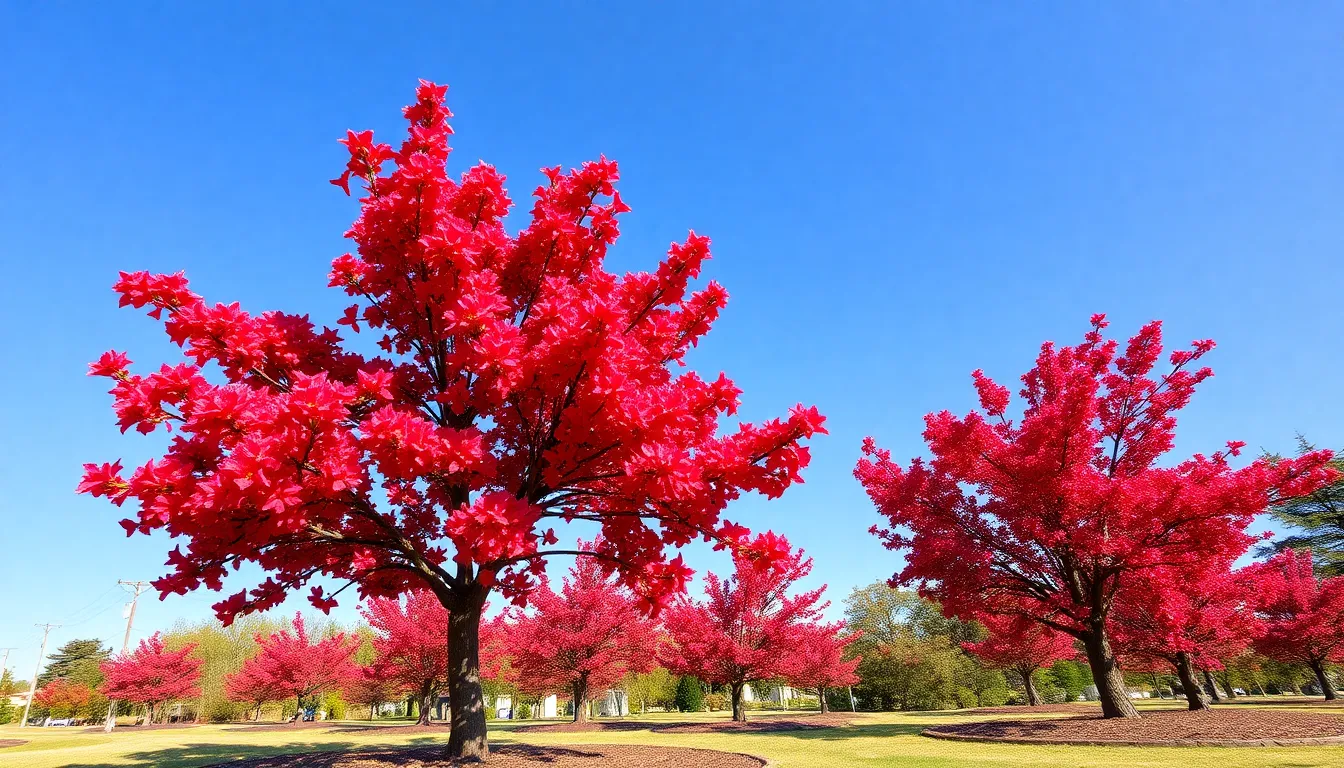
Proper seasonal care ensures your red flowering trees maintain their vibrant blooms and healthy growth throughout the year. Following exact guidelines for each season helps these stunning industry features thrive in various climate conditions.
Spring Planting and Pruning Guidelines
Plant your red flowering trees in early spring when soil temperatures begin to warm and frost danger passes. Red Flowering Gum (Corymbia ficifolia) and Eastern Redbud establish best during this period, requiring well-drained soil and full to partial sunlight exposure.
Choose locations with adequate drainage to prevent root rot and ensure optimal growth conditions. Most red flowering trees prefer slightly acidic to neutral soil pH levels between 6.0 and 7.0.
Prune young trees immediately after planting to establish strong structural frameworks that support future growth. Remove weak, crossing, or damaged branches using clean, sharp pruning tools to prevent disease transmission.
Time your pruning activities for late winter or early spring before new growth begins. This timing allows trees to heal quickly and direct energy toward healthy branch development.
Focus on creating balanced canopies by removing competing central leaders and maintaining proper spacing between major branches.
Summer Watering and Maintenance
Water regularly during summer months to maintain consistent soil moisture without creating waterlogged conditions. Red Flowering Gums become drought tolerant once established but still require deep watering during extended dry periods.
Apply water slowly and deeply to encourage root systems to grow downward rather than remaining shallow. Soaker hoses or drip irrigation systems provide efficient water delivery methods for established trees.
Fertilize with high quality granular fertilizer in spring, summer, and autumn to promote healthy growth and abundant flowering. Choose balanced fertilizers with equal nitrogen, phosphorus, and potassium ratios for optimal results.
Monitor for pest activity and disease symptoms throughout the growing season. Common issues include aphids, scale insects, and fungal infections that can affect bloom quality and tree health.
Maintain 2 to 4 inch mulch layers around tree bases to retain moisture and suppress weed competition. Keep mulch several inches away from trunk areas to prevent pest harboring and moisture related problems.
Fall and Winter Protection Methods
Prune during dry fall weather to maintain natural growth habits and remove dead or diseased branches. This timing reduces disease transmission risks and prepares trees for winter dormancy periods.
Apply protective mulch layers before winter temperatures arrive to insulate root systems and prevent freeze damage. Organic mulches like wood chips or shredded leaves provide excellent insulation properties.
Provide wind protection for newly planted or exposed trees using burlap screens or temporary windbreaks. Strong winter winds can damage delicate branches and desiccate evergreen foliage.
Reduce watering frequency as temperatures drop and growth slows down. Overwatering during dormant periods can lead to root rot and other moisture related issues.
Inspect trees regularly for winter damage including broken branches, ice accumulation, and signs of rodent activity around trunk bases.
Design Ideas for Incorporating Red Flowering Trees
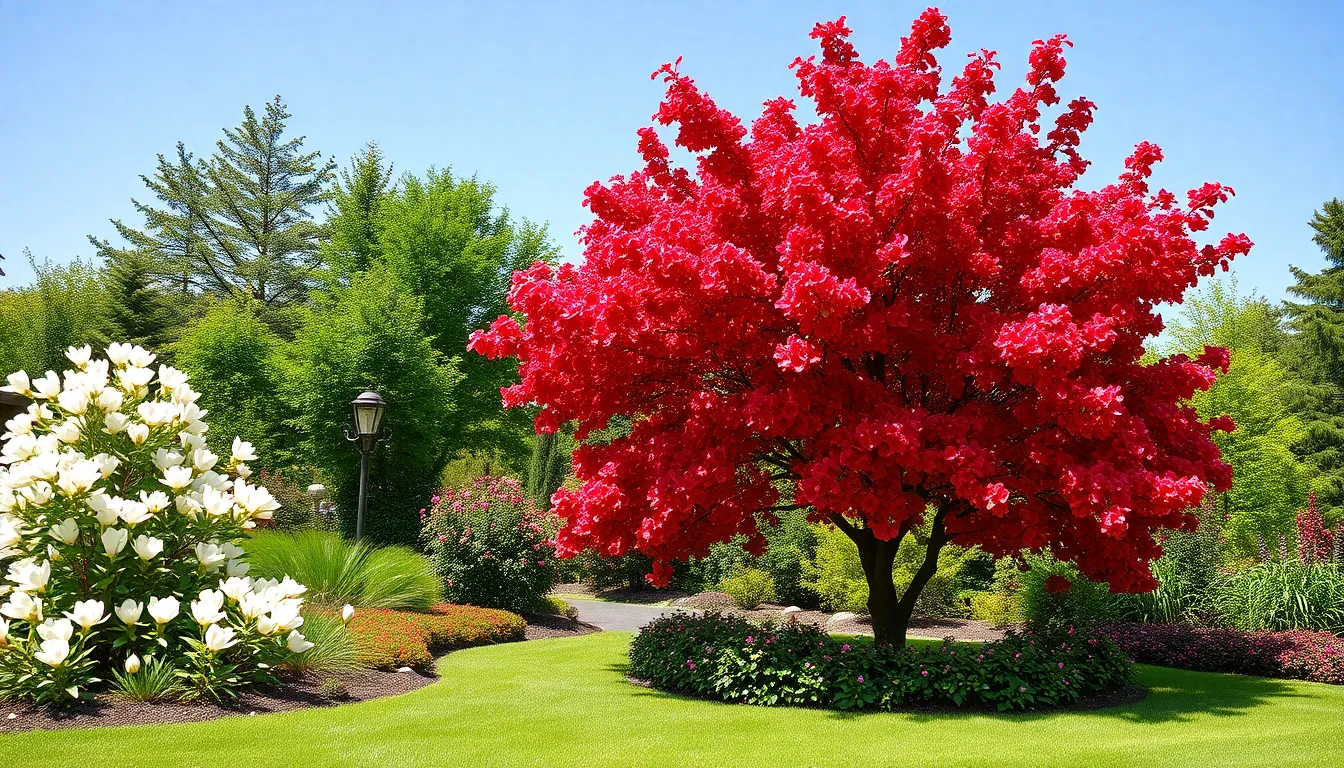
Strategic placement of red flowering trees transforms ordinary landscapes into captivating outdoor spaces. We’ll explore effective design approaches that maximize the visual impact of these stunning specimens.
Creating Focal Points in Industry Design
Central positioning creates the most dramatic impact when incorporating red flowering trees into your industry. Plant a prominent Red Frangipani or Red Flowering Dogwood in the center of your garden or lawn to establish an eye-catching anchor point that draws visitors deeper into your outdoor space.
Contrasting color schemes amplify the visual appeal of red flowering trees when paired with complementary plantings. Combine your Red Buckeye or Crimson King Norway Maple with white flowering magnolias or yellow flowering forsythia to create striking color combinations that make each tree’s blooms pop against the industry backdrop.
Structural interest extends beyond seasonal blooms when you select trees with distinctive bark patterns or unique branching habits. Red Flowering Dogwood offers compelling winter appeal with its layered branching structure, while Royal Poinciana provides year-round architectural drama with its umbrella-like canopy that commands attention even when not in bloom.
Border accents define garden spaces effectively using smaller red flowering varieties planted in strategic rows. Line your property boundaries with Red Buckeye trees or Eastern Redbud specimens to create natural barriers that burst with seasonal color while maintaining visual continuity throughout your industry design.
Companion Planting Suggestions
Complementary flower pairings enhance the impact of red flowering trees through thoughtful color coordination. Plant purple salvia, blue delphiniums, or lavender beneath your Red Camellia or Australian Flame Tree to create harmonious color schemes that make both the tree blooms and understory plants more vibrant.
Native plant integration supports local wildlife while creating sustainable garden ecosystems around your red flowering specimens. Incorporate native wildflowers, grasses, and shrubs that attract pollinators like bees and hummingbirds, particularly around Red Maple or Scarlet Oak trees that already provide valuable nectar sources.
Textural contrasts add visual depth when you pair red flowering trees with plants offering different foliage shapes and sizes. Combine the delicate leaves of Japanese Red Maple with bold hostas or ornamental grasses to create layered plantings that remain interesting throughout multiple seasons.
Seasonal succession extends color impact by selecting companion plants that bloom at different times than your red flowering trees. Plant spring bulbs around late-summer bloomers like Crape Myrtle, or add fall-blooming asters near early-spring specimens like Cherry Blossom trees to maintain continuous seasonal interest.
Small Space and Container Growing Options
Compact tree varieties make red flowering beauty accessible even in limited garden spaces. Choose dwarf Red Flowering Dogwood cultivars or Ruby Falls Redbud specimens that mature at smaller sizes while delivering the same spectacular blooms as their full-sized counterparts.
Container gardening opens possibilities for urban gardeners and patio spaces using appropriately sized red flowering trees. Use large containers to grow small Red Frangipani or compact Red Camellia specimens on decks, patios, or rooftop gardens where traditional planting isn’t possible.
Vertical garden integration maximizes space efficiency by training smaller red flowering trees against walls or fences. Espalier techniques work particularly well with Red Flowering Peach or Red Flowering Crabapple trees, creating living artwork that saves ground space while providing stunning seasonal displays.
Mobile industry options provide flexibility for renters or frequent movers through strategic container placement. Large planters on wheels allow you to reposition your Red Bottlebrush or compact Red Rhododendron specimens to follow optimal sunlight conditions or create temporary focal points for special occasions.
Conclusion
Red flowering trees offer us an incredible opportunity to create breathtaking landscapes that capture attention year-round. Whether we’re working with spacious yards or compact gardens these vibrant specimens provide the perfect solution for adding dramatic color and natural beauty to our outdoor spaces.
From fast-growing natives that support local wildlife to exotic tropical varieties that thrive in warmer climates we’ve explored options suitable for every gardener’s needs and growing conditions. The key lies in selecting the right species for our exact environment and providing proper seasonal care to ensure long-lasting blooms.
By incorporating these stunning trees into our industry design we’re not just planting for today—we’re investing in years of spectacular seasonal displays that will enhance our property value and create lasting memories for generations to come.
Frequently Asked Questions
What are the best red flowering trees for beginners?
Red Flowering Crabapple and Crepe Myrtle are excellent choices for beginners. Both are hardy, adaptable to various soil conditions, and relatively low-maintenance. These trees provide stunning red blooms while being forgiving of minor care mistakes, making them perfect for new gardeners looking to add vibrant color to their landscape.
When is the best time to plant red flowering trees?
Early spring is the ideal time to plant red flowering trees, typically after the last frost date in your area. This timing allows trees to establish their root systems before summer heat stress. Fall planting is also acceptable in milder climates, giving trees time to develop roots before winter dormancy.
How often should I water red flowering trees?
Water red flowering trees deeply once or twice per week during their first year, providing about 1-2 inches of water weekly. Established trees are more drought-tolerant but still benefit from regular watering during dry spells. Always check soil moisture before watering to avoid overwatering, which can cause root rot.
Which red flowering trees work best in small gardens?
Japanese Red Maple, Ruby Falls Redbud, and dwarf varieties of Red Camellia are perfect for small spaces. These compact trees typically reach 8-15 feet in height and can also be grown in large containers. Their smaller size doesn’t compromise their stunning red blooms or visual impact in limited garden areas.
Do red flowering trees attract wildlife?
Yes, many red flowering trees are excellent wildlife attractors. Red Buckeye and Red Maple attract hummingbirds and bees with their nectar-rich flowers. Cherry Blossom trees support pollinators, while flowering fruit trees can provide food for birds. These trees contribute to local ecosystem health while enhancing garden beauty.
Can red flowering trees grow in containers?
Many red flowering trees thrive in containers, especially dwarf varieties like Japanese Red Maple and compact Crepe Myrtles. Use large containers (at least 20-24 inches wide) with drainage holes and quality potting soil. Container trees require more frequent watering and fertilization but offer flexibility for renters or small space gardeners.
What’s the difference between deciduous and evergreen red flowering trees?
Deciduous red flowering trees like Red Maple and Eastern Redbud lose their leaves in winter but often provide spectacular fall color. Evergreen varieties like Red Camellia and Red Rhododendron maintain foliage year-round, offering continuous structure and seasonal blooms. Choose based on your climate and desired year-round appearance.
How do I care for red flowering trees in winter?
Winter care includes applying mulch around the base to protect roots from freezing, pruning dead or damaged branches, and wrapping young trees in harsh climates. Avoid fertilizing in late fall, as this can stimulate growth vulnerable to frost damage. Regular inspection for winter damage helps maintain tree health.
Which red flowering trees are drought-tolerant?
Royal Poinciana, Australian Flame Tree, and established Crepe Myrtles are excellent drought-tolerant options. Red Flowering Oleander and mature Red Maple also handle dry conditions well. These trees are perfect for water-wise landscaping or regions with limited rainfall, requiring minimal irrigation once established.
How can I create year-round color with red flowering trees?
Plant a variety of red flowering trees with different bloom times: Red Buckeye for early spring, Cherry Blossom for mid-spring, Crepe Myrtle for summer, and trees with red fall foliage like Scarlet Oak. Combine with evergreen red flowering varieties like Red Camellia for winter interest and continuous color throughout seasons.
